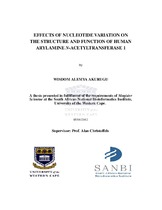| dc.description.abstract | The human arylamine N-acetyltransferase 1 (NAT1) is critical in determining the duration of action and pharmacokinetics of amine-containing drugs such as para-aminosalicylic acid and para-aminobenzoyl glutamate used in clinical therapy of tuberculosis (TB), as well as influencing the balance between detoxification
and metabolic activation of these drugs. SNPs in this enzyme are continuously being detected and indicate inter-ethnic and inter-individual variation in the enzyme function. The effect of nsSNPs on the structure and function of proteins are routinely analyzed using SIFT and POLYPHEN-2 prediction algorithms. The false-negative rate of these two algorithms results in as much as 25% of nsSNPs. This
study aimed to explore the use of homology modeling including residue interactions, Gibbs free energy change and solvent accessibility as additional evidence for predicting nsSNP effects on enzyme function.This study evaluated the functional effects of 14 nsSNPs identified in a South African mixed ancestry
population of which 3 nsSNPs were previously identified in Caucasians. The SNPs were evaluated using structural analysis that included homology modeling, residue interactions, relative solvent accessibility,Gibbs free energy change and sequence conservation in addition to the routinely used nsSNP function prediction algorithms, SIFT and POLYPHEN-2. The structural analysis implemented in this study showed
a loss of hydrogen bonds for S259R thereby affecting protein function which contradicts predictions obtained from SIFT and POLYPHEN-2 algorithms. The variant N245I was shown to be neutral but contradicted the predictions from SIFT and POLYPHEN-2. Structural analysis predicted that variant R242M would affect protein stability and therefore NAT1 function in agreement with POLYPHEN-2 predictions
but contradicting predictions from SIFT. No structural changes were expected for variant E264K in agreement with predictions obtained from POLYPHEN-2 but contradicting results from SIFT. The functions of the remaining 10 nsSNPs were consistent with those predicted by SIFT and POLYPHEN-2 namely that four variants R117T, E167Q, T193S and T240S do not affect the NAT1 function whereas R166T,
F202V, Q210P, D229H, V231G and V235A could affect the enzyme function.This study provided the first evaluation of the functional effects of 11 newly characterized nsSNPs on the NAT1 tuberculosis drug-metabolizing enzyme. The six functionally important nsSNPs predicted by all three methods and the four SNPs with contradictory results will be tested experimentally by creating a SNP construct that will be cloned into an expression vector. These combined computational and
experimental studies will advance our understanding of NAT1 structure-function relationships and allow us to interpret the NAT1 genetic polymorphisms in individuals who are slow or fast acetylators. The results, albeit a small dataset demonstrate that the routinely used algorithms are not without flaws and
that improvements in functional prediction of nsSNPs can be obtained by close scrutiny of the molecular interactions of wild type and variant amino acids. | en_US |

